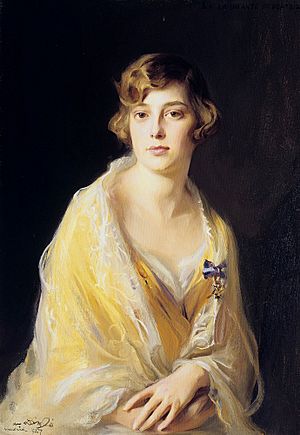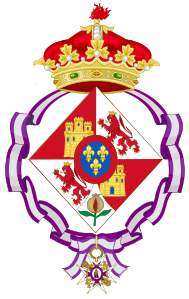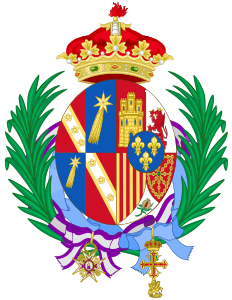Infanta Beatriz of Spain facts for kids
Quick facts for kids Infanta Beatriz |
|||||
|---|---|---|---|---|---|
| Princess of Civitella-Cesi | |||||

Portrait by Philip de László, 1927
|
|||||
| Born | 22 June 1909 Royal Palace of La Granja de San Ildefonso, Segovia, Spain |
||||
| Died | 22 November 2002 (aged 93) Palazzo Torlonia, Rome, Italy |
||||
| Burial | Campo Verano, Rome, Italy | ||||
| Spouse |
Don Alessandro Torlonia, 5th Prince of Civitella-Cesi
(m. 1935; died 1986) |
||||
| Issue |
|
||||
|
|||||
| House | Bourbon | ||||
| Father | Alfonso XIII of Spain | ||||
| Mother | Victoria Eugenie of Battenberg | ||||
| Religion | Roman Catholic | ||||
Infanta Beatriz of Spain (born Beatriz Isabel Federica Alfonsa Eugénie Cristina Maria Teresia Bienvenida Ladislàa de Borbón y Battenberg; June 22, 1909 – November 22, 2002) was a Spanish princess. She was the daughter of King Alfonso XIII and Queen Victoria Eugenie.
Beatriz was also the aunt of King Juan Carlos I, who later ruled Spain. She married Alessandro Torlonia, an Italian prince.
Contents
Growing Up Royal in Spain
Infanta Beatriz was born on June 22, 1909, at the royal palace of La Granja in Spain. She was the third of six children born to King Alfonso XIII and Queen Victoria Eugenie. Her full name was very long, including names from her grandmothers and other important family members.
Beatriz and her siblings grew up in the Palacio de Oriente. They had English nannies and learned English and French, along with Spanish. They spoke English with their mother and Spanish with their father.
The royal children studied languages, history, and religion. They also took piano and dancing lessons. Their parents believed that being active outdoors was important. Beatriz loved sports like swimming, tennis, golf, and horseback riding. In the summer, the family moved to Palacio de la Magdalena near Santander, where they enjoyed water sports.
A Young Princess's Life
As a young woman, Infanta Beatriz and her sister Infanta Cristina took part in many official events. They supported different organizations, including those for animal protection. They even took nursing classes and helped at the Red Cross in Madrid. Beatriz became president of the Red Cross in San Sebastián.
Beatriz was known for her elegant style. She was tall and lean, like her father, with dark hair. Her official introduction to society was a grand ball at the royal palace in 1927.
However, a serious health condition called hemophilia affected her family. Her oldest and youngest brothers had hemophilia, which means their blood did not clot properly. Her second brother, Jaime, was deaf. Only her third brother, Juan, was completely healthy.
In 1929, Beatriz fell in love with Miguel Primo de Rivera y Sáenz de Heredia. He was the son of the Spanish Prime Minister. However, a marriage between a princess and someone not from a royal family was not allowed at that time. Also, because Beatriz and her sister could carry the gene for hemophilia, it was hard for them to find royal husbands.
Life in Exile
In 1931, the political situation in Spain changed. The king's rule became unpopular, and the Second Spanish Republic was declared. King Alfonso XIII had to leave Spain.
Infanta Beatriz, her mother, and her siblings also left Madrid. They traveled by car and train to France. Their first home in exile was a hotel in Paris, then a private part of a hotel in Fontainebleau.
The king and queen had lived separate lives even in Spain, and they separated permanently in exile. Queen Victoria Eugenie moved to London and then Switzerland. Beatriz and her sister lived with her for a while. Later, they moved to Italy to be with their father, King Alfonso. They became friends with the Italian royal family and enjoyed life in Rome.
In 1934, a sad event occurred. Beatriz was driving a car in Austria with her brother Gonzalo. To avoid a cyclist, she crashed the car into a wall. Gonzalo, who had hemophilia, suffered internal bleeding and sadly died the next day.
Marriage and Family Life
After her brother's death, Infanta Beatriz prepared for her wedding. She met Alessandro Torlonia, an Italian aristocrat, in Ostia, Italy. Alessandro's family had become wealthy by managing the Vatican's finances. They received the title of Prince of Civitella-Cesi in 1803.
Even though Alessandro was a prince, he was not from a ruling royal family. This meant Beatriz had to marry him in a special way called a morganatic marriage. This meant she gave up her rights to the Spanish throne. King Alfonso XIII agreed to this marriage because of the challenges of finding royal husbands for his daughters, especially with the risk of hemophilia.
The wedding took place on January 14, 1935, in Rome. It was a grand event with many royal guests. Thousands of Spaniards traveled from Spain to show their support for the royal family.
Infanta Beatriz and Alessandro had four children:
- Sandra Torlonia (1936–2014)
- Marco Torlonia, 6th Prince of Civitella-Cesi (1937–2014)
- Marino Torlonia (1939–1995)
- Olimpia Torlonia (born 1943)
Later Years
Infanta Beatriz and her husband lived in the Palazzo Torlonia, a beautiful old house in Rome. When World War II made conditions difficult in Italy, Beatriz and her family moved to Switzerland to be near her mother. After the war, she returned to Italy and lived there for the rest of her life.
In 1950, Beatriz visited Spain for the first time since leaving in exile almost 20 years earlier. She visited her birthplace, La Granja, and other important places. She received so much support from the Spanish people that the government asked her to leave the country after only a week.
Her children also had interesting lives. Her daughter Sandra married Clemente Lequio. Their son, Alessandro Lequio, became well-known in Spain. Beatriz's eldest son, Marco, married three times and had three children. Her second son, Marino, sadly died unmarried in 1995. Her youngest child, Olimpia, married Paul-Annick Weiller. Their daughter, Sibilla, later became a princess of Luxembourg.
Infanta Beatriz always loved Spain and supported her brother Juan's claim to the Spanish throne. She attended her nephew Juan Carlos's wedding in Greece in 1962. Although her health declined later in life, she made several more visits to Spain. She visited La Granja again in 1998 and the Palacio de la Magdalena in 2001, where she had spent many summers as a child.
Infanta Beatriz passed away at her home in Rome on November 22, 2002, at the age of 93. She was the last surviving child of King Alfonso XIII.
Honours
 Spain: 1,094th Dame Grand Cross of the Order of Queen Maria Luisa
Spain: 1,094th Dame Grand Cross of the Order of Queen Maria Luisa
Arms
- Heraldry of Infanta Beatriz of Spain
-
Coat of arms used during King Juan Carlos's reign
Ancestry
| Ancestors of Infanta Beatriz of Spain | |||||||||||||||||||||||||||||||||||||||||||||||||||||||||||||||||||||||||||||||||||||||||||||||||||||||||||||||||||||||||||||||||||||||||||||||||||||||||||||||||||||||||||||||||||||||||||||||||||||||||||||||||||||||||||||||||||||||||||||||||||||||||||||||||||||||||||||||||||||||||
|---|---|---|---|---|---|---|---|---|---|---|---|---|---|---|---|---|---|---|---|---|---|---|---|---|---|---|---|---|---|---|---|---|---|---|---|---|---|---|---|---|---|---|---|---|---|---|---|---|---|---|---|---|---|---|---|---|---|---|---|---|---|---|---|---|---|---|---|---|---|---|---|---|---|---|---|---|---|---|---|---|---|---|---|---|---|---|---|---|---|---|---|---|---|---|---|---|---|---|---|---|---|---|---|---|---|---|---|---|---|---|---|---|---|---|---|---|---|---|---|---|---|---|---|---|---|---|---|---|---|---|---|---|---|---|---|---|---|---|---|---|---|---|---|---|---|---|---|---|---|---|---|---|---|---|---|---|---|---|---|---|---|---|---|---|---|---|---|---|---|---|---|---|---|---|---|---|---|---|---|---|---|---|---|---|---|---|---|---|---|---|---|---|---|---|---|---|---|---|---|---|---|---|---|---|---|---|---|---|---|---|---|---|---|---|---|---|---|---|---|---|---|---|---|---|---|---|---|---|---|---|---|---|---|---|---|---|---|---|---|---|---|---|---|---|---|---|---|---|---|---|---|---|---|---|---|---|---|---|---|---|---|---|---|---|---|---|---|---|---|---|---|---|---|---|---|---|---|---|---|---|---|
|
|||||||||||||||||||||||||||||||||||||||||||||||||||||||||||||||||||||||||||||||||||||||||||||||||||||||||||||||||||||||||||||||||||||||||||||||||||||||||||||||||||||||||||||||||||||||||||||||||||||||||||||||||||||||||||||||||||||||||||||||||||||||||||||||||||||||||||||||||||||||||
See also
 In Spanish: Beatriz de Borbón y Battenberg para niños
In Spanish: Beatriz de Borbón y Battenberg para niños




